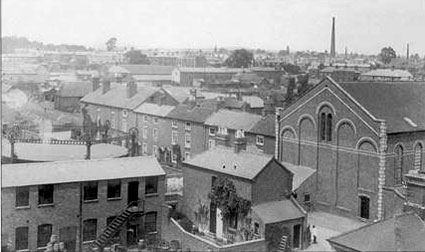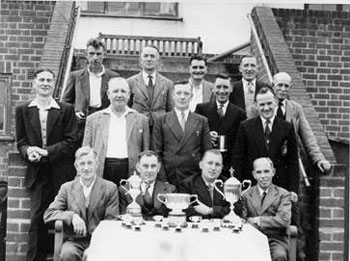|
Charles Henry
Burton (1897-1990)
by David Burton
EARLY LIFE
My
father, Charles (known as Charlie), was born
at 12 Cheapside, Stourport on 12th
March 1897 the second youngest of twelve
surviving children.
(The area is seen below right).
He
 attended
Stourport Boys
School and received medals for unbroken
attendance during 1903-1905 and 1906-1907 and
a book prize for Sunday School attendance in
1910. His mother died when he was thirteen and
he was effectively brought up and indeed,
dominated, by his seven sisters. He took the
first opportunity to leave home,
joining the army, aged 16, four years later.
He never forgave his sisters for what he saw
as a harsh home regime and we had very little
to do with most of them in later life. The
boyhood experience
seems
to have affected him by making him withdraw
into his own world,
not particularly needing the company of
others. attended
Stourport Boys
School and received medals for unbroken
attendance during 1903-1905 and 1906-1907 and
a book prize for Sunday School attendance in
1910. His mother died when he was thirteen and
he was effectively brought up and indeed,
dominated, by his seven sisters. He took the
first opportunity to leave home,
joining the army, aged 16, four years later.
He never forgave his sisters for what he saw
as a harsh home regime and we had very little
to do with most of them in later life. The
boyhood experience
seems
to have affected him by making him withdraw
into his own world,
not particularly needing the company of
others.
In the
1911 census
Charlie
was described as an under-gardener,
presumably his first job. However he spent the
rest of his working life with the local
tannery of Henry Beakbane. In 1914 he was a
belt maker
before volunteering for Army service.
His war service is described in detail below.
WAR SERVICE 1914-1919
Charlie Burton
attested for the army at Stourport on 11th
February 1914, joining the
7th
Battalion, Worcestershire Regiment. The
next two years he spent training whilst
awaiting the age of 19 and being allowed to
fight. He finally sailed for France to join
the war with the 1st Battalion of
the Worcesters, from Southampton, in February
1916.
When he joined the
Battalion it was near
the mining village of
Bruay in the
Nord Pas de
Calais region, north-west of
Arras. Until late
June he was alternately in the trenches or in
reserve billets in this region. Then in the
last week of June the Battalion
moved south to
join the concentration on
the Somme. Luckily
they were in reserve billets in
Raineville on
1st July when the British Army
suffered massive casualties on the first day
of the battle.
On 7th July the
battalion joined the attack on
Contalmaison.
After fierce fighting, involving many
attacks and counter attacks, the enemy was
eventually driven out of the village. The
battalion lost nearly 350 men of all ranks. A
few days later the
Battalion went north by
train to Bethune and for the next three months
were in and out of the line near
Cuinchy. some
8 km to the east. Then, in mid October
they went by train back to the battlefields of
the Somme. After detraining they made their
way to trenches near
Gueudecourt where they
were shelled incessantly. However British
barrages enabled them to make a small advance.
They carried on moving in and out of the line
around Carnoy until the end of the year.
In
the New
Year the 1st Worcs moved up
to the heights above the Somme moving into
trenches east of Bouchavesnes from where they
were to launch an attack. On 4th
March the attack took place as the Britsh
artillery opened up a barrage and all along
the line the troops swarmed out of the
trenches. The attack was immediately
successful and the trenches on the
Epehy ridge
were secured. During April and May the
Battalion went into new positions near
Gouzeaucourt and
Honnecourt before retiring to
Moislains for training.
After more than a year
in the trenches
Dad developed trench foot in
May 1917 and went into hospital in
Rouen to
recover for a couple of months. After 10 days
leave in the UK he was posted back to the
10th
Worcesters in September.
He
joined the
Battalion at
Corruna Camp
near
Westoutre and three days later went to the
battle area (Battle of the Menin Road Ridge near
Ypres). At dawn on 20
September the British battalions advanced and
were completely successful and captured ground
was quickly entrenched. Losses to the
battalion totalled 150. Two days later the
Battalion settled down in
Fermoy Camp
at
Locre
for a well earned rest.
They moved back into
the salient on 26 September and
moved up to forward positions on 1st
October. Three days later, at dawn, an attack
(Battle of Broodseinde) began with the
artillery opening fire and the troops pushing
forward to assault. Unfortunately they only
gained a few yards of ground and during the
action Dad was wounded in the right knee by a
piece of shrapnel. He was then repatriated
spending 33 days in hospital.
After about 4
months recuperating at the Command Depot in
Ballyvonare, County Cork he was sent back to
France in March 1918. He joined the
1st
Battalion of the Worcesters on 9th
April whilst it was lying at
Soyes east of
Amiens. By 19th April the
Battalion
was in trenches on the southern outskirts of
Villers Brettonneux. The Germans launched a
bombardment early on the 24th and
followed with an assault by tanks and
infantry. The Worcesters put up a gallant
struggle but were overrun until aided by
British tanks (the first duel between tanks
that ever took place). The next day a counter
attack was launched and by midday the enemy
had been driven out of the village
(The Action
of Villers Bretonneux).
On May
3rd and 4th the
Battalion was transported by train from
Saleux to
Fismes and by the 11th moved
into the front line in trenches facing
Juvincourt. After a few days in the trenches
and a few days training they were back in the
front line by 24th. Two days later
it was sensed the enemy was preparing for
action and battle stations were manned.
On 27th
the Germans commenced the last phase of their
great gamble for victory. Following a heavy
bombardment of the British trenches north of
the River Aisne enemy tanks and artillery
advanced in thick mist. In short time the
Battalion was surrounded and attacked in
front, flank and rear and only a few
stragglers got back (Battle of the Aisne).
Dad suffered gassing due to a shell and was
captured by the enemy. This was confirmed by a
postcard to his parents in August saying,
however, that he was well.
After the end of
the war he apparently returned from France in
December 1918 and was eventually disembodied
at Warwick in April 1919.
LATER LIFE
After demobilisation in April 1919 Dad
married my mother, Doris
May Tipper, at
Stourport Church in
February 1920 and soon
afterwards my sister, Eileen, was born. They
all lived in a cottage in
Severnside,
Stourport with my grandmother,
Dorcas Birch,
and her aunt, Charlotte Whitmore, together
with mom’s sister, Freda. Privacy and space
must have been at a premium which perhaps
explains the lack of further children until I
was born. The cottage was only the width of a
path from the water of the River Severn.
Dad had returned to Beakbane's after
the War and was by then working as a dyer of
leather, a job which continued for many years
- right up until 1964 when the tannery burned
down and he
moved
to Beakbane’s manufactory near Kidderminster,
where he was employed cutting out leather for
bellows. In
about 1933 Mom and Dad moved into a rented
house in Lombard Street, Stourport very close
to the tannery where
Dad worked. During the
second World War
Dad joined the Home Guard and
was made a sergeant, presumably because of his
previous army experience. I was born at the
very end of the war. Then
in
about 1970, after I had
left home,
they
moved to a
council old people’s bungalow in
Cedar Close,
Stourport. Dad was 75 years of age when
he finally retired, having given almost 60
years of service to his Company apart from his
years in the Army.
 Dad’s
main forms of relaxation were fishing, bowls and
crib. He enjoyed these through Stourport pubs,
including
The Royal Oak,
The Angel and
The Tontine.
Here is a happy group
(left)
of memebers of the
Old Anchor Bowling Club.
In
earlier days he had an allotment in
Lickhill
Road but must have given it up whilst I was
still young. Dad’s
main forms of relaxation were fishing, bowls and
crib. He enjoyed these through Stourport pubs,
including
The Royal Oak,
The Angel and
The Tontine.
Here is a happy group
(left)
of memebers of the
Old Anchor Bowling Club.
In
earlier days he had an allotment in
Lickhill
Road but must have given it up whilst I was
still young.
He suffered from
bronchitis for a lot of his life, maybe as a
result of the gas, and was in
Kidderminster
Hospital when
Mom
died in January 1989. He never returned home
again and went to
Astley House nursing home
where he eventually died in July 1990
at the age of 93.
Acknowledgement
to "The Worcester Regiment in the Great War"
by Capt. H F Stacke for some of the
information in the above article.
|